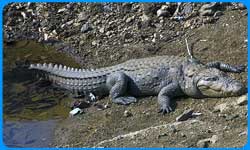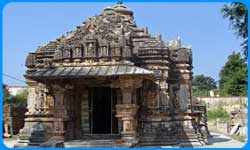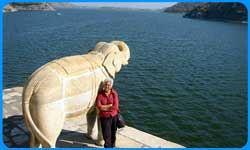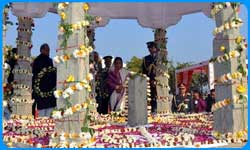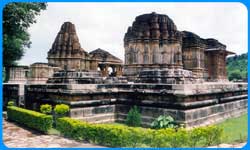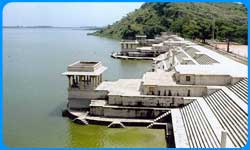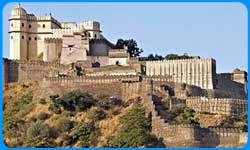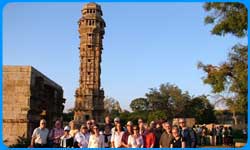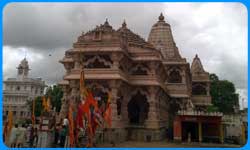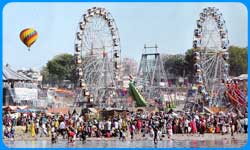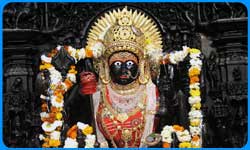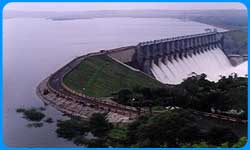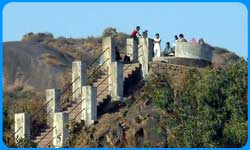Tourist Place Around Udaipur
Bagdara Nature Park:
Baghdada:Crocodile park and habitate center, 12 kn south of Udaipur Bagdara nature park.
Lake Udai Sagar:
Udai Sagar Lake is another striking lake that falls under the category of five lakes of Udaipur. Udaisagar Lake is located at a distance of about 13 kms in the east of Udaipur. The construction of this lake was started in 1559 by Maharana Udai Singh and got completed in 1565. Udai Sagar Lake extends to 4 km in length 2.5 km in width and deep to the extent of 9 meters at the maximum. Actually, Udai Sagar Lake was the result of a dam that took its start in 1559.
Jagat (Ambica Temple):
The village Jagat is popular with the term of 'Khajuraho of Rajasthan' and the place is particularly famous for its well-preserved temple of the 10th century. Though Ambika Mata Temple is not very big, but its splendid architecture makes it different from others. The main shrine has an image of Ambika, a form of the Hindi Goddess Durga. The goddess is worshipped as Shakti (Power) that is a primitive source of energy. Goddess Ambika is linked with Maa Durga due to the presence of Lion as her mount.
Lake Jaisamand :
Jaisamand Lake -Second Biggest Artificial Lake :- Jaisamand Lake is also known as Dhebar.The lake, built by Maharana Jai Singh in 1685, is the second biggest artificial lake of the world covering an area of 36sq km. The lake remained the largest artificial lake in the world till the building of the Aswan dam in Egypt. The statistics of the lake is really amazing – 9 miles in breadth, 102 feet deep at its deepest end, a circumference of 30 miles with marble staircases leading into the water.
Chawand (Maharana Pratap Samadhi):
am a native of this place currently employed in Maharastra.This place can be a amazing one for those person who are interested in history.Because this spot was the third capital of Mewar(first was udaipur and Second was Gogunda).This place is completly surrounded by nice hills and very thick forest.That was one of the major reason so Maharana Pratap made it as capital of Mewar empire.This place have old palace of Maharana and statue of their petriot horse Chetak.
Haldighati:
Haldighati is an important historical site in the context of Rajasthan, India. Actually, Haldighati is a mountain pass in the Aravalli range connecting districts of Rajsamand and Pali in Rajasthan. The place is at a comfortable distance of 40 kms from the city of Udaipur. The term Haldighati has been derived from the yellow colored soil of the place that gives a sense of turmeric (in Hindi, turmeric is called as 'Haldi' and valley is known as' Ghati').
Shrinathji Temple(Nathdwara):
The story of ShreeNathji is the amazing history of His worship, travels and lilas. ShreeNathji's manifestation and the subsequent developments were originally revealed by Shri Gokulnathji, the grandson of Shri Mahaprabhuji Vallabhacharya who appeared in India in the year 1479 on exactly the same day that ShreeNathji’s face appeared from hill. ShreeNathji stayed on the Govardhan Hill for as long as Shri Mahaprabhu, his son Shri Gusainji and his seven sons lived on the earth. Shri Gokulnathji was Shri Guisainji’s illustrious fourth son and composed an ocean of devotional literature mostly in Sanskrit and Braja language.
Eklingji Temple (Kailashpuri):
Eklingji Temple is one of the most famous temples of Rajasthan. Located in the town of Eklingji (Kailashpuri), the place got its popular name from the temple. Eklingji Temple is positioned at a distance of 22 km in the north of Udaipur, on the national highway no. 8. Eklingnath Temple is dedicated to the Lord Shiva of the Hindu religion. Initially, the temple was built in 734 A.D. by Bappa Rawal.
Nagda Temple:
Nagda is a small town in the Indian state of Rajasthan. In the 6th century, Nagda was found by Nagaditya, the fourth Mewar King. Initially it was known as Nagahrida and served as the capital of Mewar. Before long, the place came under the province of Sisodias. Nagda is located besides Bagela Lake at a distance of 23 kms in the north-west of Udaipur on the way to Nathdwara. Nagda comprises many small and big temples, but the main attraction is gained by its 'Sas-Bahu' temple.
Lake Rajsamand:
The city of Udaipur that is popularly known as the 'city of the lakes' is a land that plunges in natural beauty. Dotted by a number of beautiful lakes, lush hills of the Aravallis, the city of Udaipur is a fabulous land that overwhelms one. The natural beauty that has been the inspiration of the poets, painters, and writers from times immemorial perfectly blends natural beauty with a tinge of modernity in it. Of the innumerable spots that you can choose for Excursions around Udaipur, the Rajsamand Lake is one of the best options that most of the tourists love to visit.
Ranakpur Temple:
Ranakpur Temples are acclaimed world-wide for their intricate and superb architectural style. These temples form one of the five major pilgrimages of the Jains. Located in village of Ranakpur near Sadri town in the Pali district of Rajasthan, Ranakpur temple lies at a distance of 95 kms in the north of Udaipur city. The temple is easily accessible from the city of Udaipur as regular buses are easily available. Built in the 15th century, Ranakpur temples are known for being the largest and most important temples of the Jain cult.
Kumbhalgarh Fort:
Kumbhalgarh Fort is the second most important fort of Rajasthan after Chittorgarh. Located at a distance of 64 kms from Udaipur in Rajasmand district, Kumbhalgarh Fort is easily accessible from the city of Udaipur. This unconquerable fortress is secured under the kind protection of the Aravali ranges. Kumbhalgarh Fort was built by Maharana Rana Kumbha in the 15th century. The fort derived its name from the same factor.
Chittorgarh Fort:
Standing on a rocky plateau on a 500 feet high hill, the 700 acre fort went through three sieges, and each time Chittor turned out the loser. But that did not mean that the fort was inferior to any other in Rajasthan. It was just that that the Rajputs had a habit of riding out to meet the enemy outside the safety of their walls instead of allowing the enemy to launch the first assault. The first time the fort was stormed in 1303AD, it was purely for matters of the heart.
sanwariyaji Temple:
It is a famous temple of Lord Krishna and an important pilgrimage spot. The Temple is located on the Chittorgarh - Udaipur road.The Sanwariya ji temple is recently renovated and beautifully builds with glasses.The temple is especially famous among Opium Farmers. The temple is also famous due to the huge donation it recieves from hundreds of visitors every day.Opium is legally grown in India and exported to the Pharmaceutical industry worldwide to manufacture Morphine-based pain-killers.
kesariyaJi Temple:
Better known as Kesariyaji, is situated 40km from Udaipur. It is dedicated to Lord Rikhabdev, the first jain Tirthankara. Rikhabdev is well known for its Adinath or Rikhabdev Temple.Rikhabdev is famous only for its temple dedicated to Lord Rikhabdev, the first Jain Tirthankara. Rikhabdev is also claimed by the Vaishnavas as the eighth Avatar of Lord Vishnu. The temple belongs to the Svetambara sect of the Jains but at present is under the control of the State of Rajasthan. The temple is better known as Kesariyaji, derived from kesar or saffron that is put on the forehead of the idol of the Lord.
Juna Mahal (Dungarpur):
The seven history palace, Juna Mahal was built in stages between 13th and 18th centuries. It is filled with many old frescoes and paintings. The Aam Khas, or main living room, has impressive mirror work and glass inlays. The former royal hunting lodge, on a nearby hilltop, has sensational views over the town and its many temples. The magnificent apartments of 13th century seven storied fortress Juna Mahal (Old Palace) are breathtaking.
Beneshwar Dham (Dungarpur):
The name Baneshwar is derived from the revered Shiva Linga which is kept in the Mahadev temple in Dungarpur. "Baneshwar" means the 'master of the delta' in the local Vagdi language and this name was given to Shiva Linga.The Baneshwar fair is held at a small delta formed by the river Som and Mahi, from Magh Shukla Ekadashi to Magh Shukla Poornima during Shivratri. (Jan-Feb).
Tripura Sundari (Banswara):
The place gets its name from a temple here dedicated to goddess Tripura Sundari also called Turtia Mata in the local dialect. It is believed that the temple was constructed approximately before the reign of the Kushana emperor Kanishka who ruled here in the first century AD. Magnificently carved out of black stone, the main idol is shown riding a tiger. The goddess has 18 hands each carrying a symbol. The temple is said to be one of the Shakti Peeths of the Hindus. A Shakti Peeth is a revered place of worship of the Hindus.
Mahi Sagar Dam (Banswara):
Home to the tribal with Bhils constituting half of the total population, Banswara has its name derived from `Bans' or bamboo trees, which once grew here in abundance.The erstwhile state was founded by Maharawal Jagmal Singh. Bounded by Udaipur and Chittaurgarh, the district presently comprises of the territories of former Banswara State and the Chieftainship of Kushalgarh.
Mount Abu:
The history of Mount Abu is as diverse as the city itself. It was once a part of the Chauhan kingdom of Rajasthan and served as a summer resort for the Rajput kings of the region. After that, it was leased by the British government from the then Maharaja of Sirohi for use as the headquarter of the resident to Rajputana (another name for Rajasthan).During the British rule in India, it was the favorite summer destination of the British, who came here to escape the dusty, dry heat of the plains particularly Rajasthan.
Baghdada:Crocodile park and habitate center, 12 kn south of Udaipur Bagdara nature park.
Lake Udai Sagar:
Udai Sagar Lake is another striking lake that falls under the category of five lakes of Udaipur. Udaisagar Lake is located at a distance of about 13 kms in the east of Udaipur. The construction of this lake was started in 1559 by Maharana Udai Singh and got completed in 1565. Udai Sagar Lake extends to 4 km in length 2.5 km in width and deep to the extent of 9 meters at the maximum. Actually, Udai Sagar Lake was the result of a dam that took its start in 1559.
Jagat (Ambica Temple):
The village Jagat is popular with the term of 'Khajuraho of Rajasthan' and the place is particularly famous for its well-preserved temple of the 10th century. Though Ambika Mata Temple is not very big, but its splendid architecture makes it different from others. The main shrine has an image of Ambika, a form of the Hindi Goddess Durga. The goddess is worshipped as Shakti (Power) that is a primitive source of energy. Goddess Ambika is linked with Maa Durga due to the presence of Lion as her mount.
Lake Jaisamand :
Jaisamand Lake -Second Biggest Artificial Lake :- Jaisamand Lake is also known as Dhebar.The lake, built by Maharana Jai Singh in 1685, is the second biggest artificial lake of the world covering an area of 36sq km. The lake remained the largest artificial lake in the world till the building of the Aswan dam in Egypt. The statistics of the lake is really amazing – 9 miles in breadth, 102 feet deep at its deepest end, a circumference of 30 miles with marble staircases leading into the water.
Chawand (Maharana Pratap Samadhi):
am a native of this place currently employed in Maharastra.This place can be a amazing one for those person who are interested in history.Because this spot was the third capital of Mewar(first was udaipur and Second was Gogunda).This place is completly surrounded by nice hills and very thick forest.That was one of the major reason so Maharana Pratap made it as capital of Mewar empire.This place have old palace of Maharana and statue of their petriot horse Chetak.
Haldighati:
Haldighati is an important historical site in the context of Rajasthan, India. Actually, Haldighati is a mountain pass in the Aravalli range connecting districts of Rajsamand and Pali in Rajasthan. The place is at a comfortable distance of 40 kms from the city of Udaipur. The term Haldighati has been derived from the yellow colored soil of the place that gives a sense of turmeric (in Hindi, turmeric is called as 'Haldi' and valley is known as' Ghati').
Shrinathji Temple(Nathdwara):
The story of ShreeNathji is the amazing history of His worship, travels and lilas. ShreeNathji's manifestation and the subsequent developments were originally revealed by Shri Gokulnathji, the grandson of Shri Mahaprabhuji Vallabhacharya who appeared in India in the year 1479 on exactly the same day that ShreeNathji’s face appeared from hill. ShreeNathji stayed on the Govardhan Hill for as long as Shri Mahaprabhu, his son Shri Gusainji and his seven sons lived on the earth. Shri Gokulnathji was Shri Guisainji’s illustrious fourth son and composed an ocean of devotional literature mostly in Sanskrit and Braja language.
Eklingji Temple (Kailashpuri):
Eklingji Temple is one of the most famous temples of Rajasthan. Located in the town of Eklingji (Kailashpuri), the place got its popular name from the temple. Eklingji Temple is positioned at a distance of 22 km in the north of Udaipur, on the national highway no. 8. Eklingnath Temple is dedicated to the Lord Shiva of the Hindu religion. Initially, the temple was built in 734 A.D. by Bappa Rawal.
Nagda Temple:
Nagda is a small town in the Indian state of Rajasthan. In the 6th century, Nagda was found by Nagaditya, the fourth Mewar King. Initially it was known as Nagahrida and served as the capital of Mewar. Before long, the place came under the province of Sisodias. Nagda is located besides Bagela Lake at a distance of 23 kms in the north-west of Udaipur on the way to Nathdwara. Nagda comprises many small and big temples, but the main attraction is gained by its 'Sas-Bahu' temple.
Lake Rajsamand:
The city of Udaipur that is popularly known as the 'city of the lakes' is a land that plunges in natural beauty. Dotted by a number of beautiful lakes, lush hills of the Aravallis, the city of Udaipur is a fabulous land that overwhelms one. The natural beauty that has been the inspiration of the poets, painters, and writers from times immemorial perfectly blends natural beauty with a tinge of modernity in it. Of the innumerable spots that you can choose for Excursions around Udaipur, the Rajsamand Lake is one of the best options that most of the tourists love to visit.
Ranakpur Temple:
Ranakpur Temples are acclaimed world-wide for their intricate and superb architectural style. These temples form one of the five major pilgrimages of the Jains. Located in village of Ranakpur near Sadri town in the Pali district of Rajasthan, Ranakpur temple lies at a distance of 95 kms in the north of Udaipur city. The temple is easily accessible from the city of Udaipur as regular buses are easily available. Built in the 15th century, Ranakpur temples are known for being the largest and most important temples of the Jain cult.
Kumbhalgarh Fort:
Kumbhalgarh Fort is the second most important fort of Rajasthan after Chittorgarh. Located at a distance of 64 kms from Udaipur in Rajasmand district, Kumbhalgarh Fort is easily accessible from the city of Udaipur. This unconquerable fortress is secured under the kind protection of the Aravali ranges. Kumbhalgarh Fort was built by Maharana Rana Kumbha in the 15th century. The fort derived its name from the same factor.
Chittorgarh Fort:
Standing on a rocky plateau on a 500 feet high hill, the 700 acre fort went through three sieges, and each time Chittor turned out the loser. But that did not mean that the fort was inferior to any other in Rajasthan. It was just that that the Rajputs had a habit of riding out to meet the enemy outside the safety of their walls instead of allowing the enemy to launch the first assault. The first time the fort was stormed in 1303AD, it was purely for matters of the heart.
sanwariyaji Temple:
It is a famous temple of Lord Krishna and an important pilgrimage spot. The Temple is located on the Chittorgarh - Udaipur road.The Sanwariya ji temple is recently renovated and beautifully builds with glasses.The temple is especially famous among Opium Farmers. The temple is also famous due to the huge donation it recieves from hundreds of visitors every day.Opium is legally grown in India and exported to the Pharmaceutical industry worldwide to manufacture Morphine-based pain-killers.
kesariyaJi Temple:
Better known as Kesariyaji, is situated 40km from Udaipur. It is dedicated to Lord Rikhabdev, the first jain Tirthankara. Rikhabdev is well known for its Adinath or Rikhabdev Temple.Rikhabdev is famous only for its temple dedicated to Lord Rikhabdev, the first Jain Tirthankara. Rikhabdev is also claimed by the Vaishnavas as the eighth Avatar of Lord Vishnu. The temple belongs to the Svetambara sect of the Jains but at present is under the control of the State of Rajasthan. The temple is better known as Kesariyaji, derived from kesar or saffron that is put on the forehead of the idol of the Lord.
Juna Mahal (Dungarpur):
The seven history palace, Juna Mahal was built in stages between 13th and 18th centuries. It is filled with many old frescoes and paintings. The Aam Khas, or main living room, has impressive mirror work and glass inlays. The former royal hunting lodge, on a nearby hilltop, has sensational views over the town and its many temples. The magnificent apartments of 13th century seven storied fortress Juna Mahal (Old Palace) are breathtaking.
Beneshwar Dham (Dungarpur):
The name Baneshwar is derived from the revered Shiva Linga which is kept in the Mahadev temple in Dungarpur. "Baneshwar" means the 'master of the delta' in the local Vagdi language and this name was given to Shiva Linga.The Baneshwar fair is held at a small delta formed by the river Som and Mahi, from Magh Shukla Ekadashi to Magh Shukla Poornima during Shivratri. (Jan-Feb).
Tripura Sundari (Banswara):
The place gets its name from a temple here dedicated to goddess Tripura Sundari also called Turtia Mata in the local dialect. It is believed that the temple was constructed approximately before the reign of the Kushana emperor Kanishka who ruled here in the first century AD. Magnificently carved out of black stone, the main idol is shown riding a tiger. The goddess has 18 hands each carrying a symbol. The temple is said to be one of the Shakti Peeths of the Hindus. A Shakti Peeth is a revered place of worship of the Hindus.
Mahi Sagar Dam (Banswara):
Home to the tribal with Bhils constituting half of the total population, Banswara has its name derived from `Bans' or bamboo trees, which once grew here in abundance.The erstwhile state was founded by Maharawal Jagmal Singh. Bounded by Udaipur and Chittaurgarh, the district presently comprises of the territories of former Banswara State and the Chieftainship of Kushalgarh.
Mount Abu:
The history of Mount Abu is as diverse as the city itself. It was once a part of the Chauhan kingdom of Rajasthan and served as a summer resort for the Rajput kings of the region. After that, it was leased by the British government from the then Maharaja of Sirohi for use as the headquarter of the resident to Rajputana (another name for Rajasthan).During the British rule in India, it was the favorite summer destination of the British, who came here to escape the dusty, dry heat of the plains particularly Rajasthan.
